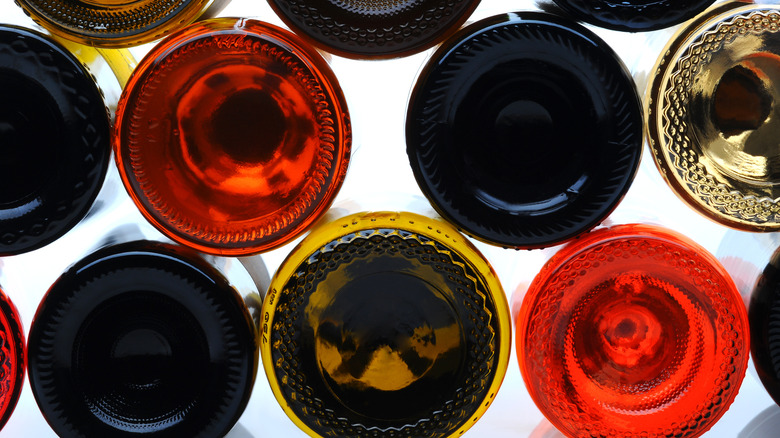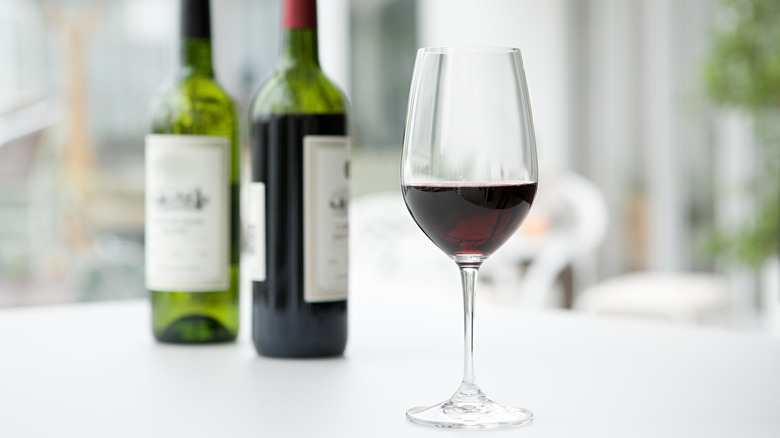Do The Indents On The Bottom Of Wine Bottles Have Any Purpose?
Have you ever gotten to the bottom of a wine bottle and wondered what that indent was for? And why it's on some bottles but not all of them? It's really not to scam you out of wine volume, we swear. Well, mostly.
First things first — that indent is called a punt. And no, you're not meant to kick it. While the punt is not meant to decrease the actual volume of wine in the bottle, it does give the bottle the subtle appearance of being bigger than it is. Other than the visual effect, there are many possible reasons the punt might be there — and not much agreement on the definitive answer.
Historically, glass bottles were blown by hand. Between small imperfections and the seam created by the process, the bottles got a little tippy. Pushing the seam up into the bottle made it a little more stable and added extra weight to the base, making it harder for the bottle to tip over of its own accord. Those seams can have sharp edges, too, and the punt protected hands while pouring. But there are some other ideas about what they could be for, too.
It's not for dregs
When wine is made, there is sediment that settles over time. It's more prevalent in certain types and treatments of wine; sparkling wine is bottled with yeast to create the bubbly's bubbles, and some wine is aged on its sediment — the "lees" — to create a full and round mouthfeel. Supposedly, the punt is meant to catch the dregs that settle to the bottom of the bottle, but it doesn't, really — the shoulder of the bottle, right near the neck, does this much more effectively if the wine is poured correctly.
Besides, wine (at least, bottles with natural corks) should always be stored on its side to prevent the corks from drying, splitting, and oxygenating the wine, prematurely turning it to vinegar. The lees settle on the side of the bottle, not on the bottom around the punt, and then get stirred up into the wine when the bottle is tipped upright for serving. They eventually drop to the bottom of the bottle while the wine is breathing, but it's not enough to demand a punt. And besides, crisp white wines and rosés often have punts but don't have lees, so that can't be it.
It's probably not for chilling or serving temperature
Speaking of crisp wines, there's a theory that the punt is meant to increase surface area for faster chilling of the wine. The issue here is that you don't typically chill red wine, and there are many red wines with punts.
There's another theory that a punt is used to create a place to hold the bottle during service. Because the serving temperature of wine is so important to its enjoyment, you'll often see sommeliers holding the bottle from the bottom by the punt. Because the glass is thicker there, this supposedly transfers less body heat from the hand to the wine. But as Chad Michael George, founder and bartender of Proof Productions in Denver, told Wine Enthusiast, "It's a pointless method and an easy way to drop a bottle on your table." And unless you're pouring at a glacial speed or have an incredibly high temperature (in which case, you shouldn't be serving anyone wine), the thermal transference from your hand through the bottle to the wine won't make that much of a difference.
They can signal quality (maybe)
These days, while wine bottles are commercially manufactured, the presence of a punt could be more of a signal than it is practical. Chris Cree, one of only 53 Masters of Wine in the U.S., told Reader's Digest, "The indirect impact is that punted bottles are more expensive, so cheap wines are not likely to use them, and by default wines in punted bottles tend to be better — or at least more expensive." While it's not a perfect metric — a wine producer could certainly save costs on a good bottle of wine by bottling in a non-punted format — it does imply a tradition of bottling that the wine industry takes very seriously.
But on the other hand, a winery can take advantage of this fact. They can take a wine that isn't quite up to par and put it in a punted bottle, and the wine buyer's mind subconsciously attributes better quality to that wine.
The best we can do here in answering this question is to attribute it to history. It's possible that at this point, the reason no one can agree on whether the punt has a purpose is because in today's wine industry ... they don't. They're simply an echo of the past, and we're used to them.



